This was published 7 years ago
Tai O Heritage Hotel, Hong Kong: Creature comfort in a converted cop shop
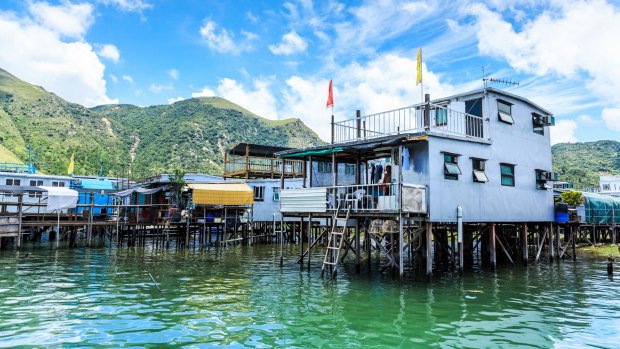
Tai O fishing village. Credit: Marco Wong
I never contemplated that my visit to Hong Kong would become quite the police matter it would turn out to be. But here I am in Tai O, a traditional fishing village about an hour from Kowloon but, in effect, a million miles removed from it. After having voluntarily detained myself here for a night I soon discover that one of the steel shutters on a window of my accommodation has several bullet holes embedded in it and the roof of the building is topped with a couple of serious-looking gun emplacements.
Of course, my brush with the Hong Kong constabulary is not quite all that it appears. Sorry to pull your leg-irons but my cell is, in fact, an extremely comfortable suite at the Tai O Heritage Hotel, a restored former early 20th-century colonial marine police station, and, to be honest, the only person behind bars here these days is the cocktail waiter at the glass-enclosed rooftop restaurant.
But the history here is all too real. Those shutters, installed to protect the police from attack, were shot up in a wild incident in 1918, while the gun turrets were erected for the surveillance of pirates in the surrounding South China Sea. Hong Kong, with its plethora of bays and inlets, as the book A Stroll through Colonial Hong Kong by Trea Wiltshire explains, served as the perfect hideout for pirates seeking to plunder coastal shipping.
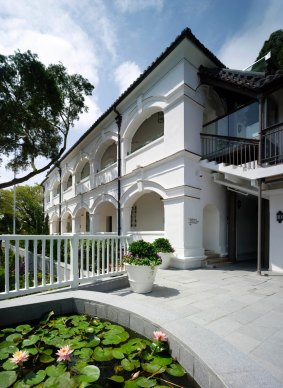
Tai O hotel.
While Singapore has been criticised for not preserving a sufficient amount of its colonial architectural past, Hong Kong has been just as guilty, perhaps even more so, of failing to protect its built past. Yet one kind of building in Hong Kong has managed to escape the demolition balls. British colonial-era police stations – just like the perfect specimen here in Tai O – after having outlived their usefulness, have been, or are being, adapted for alternative uses.
After flying into Hong Kong's International Airport the day before and, unusually turning, not left, but right for the countryside of Tai O, it's a novelty to wake up on the first full day of my visit in such a serene setting. This 1902 police station turned hotel is at end of a commanding elevated point overlooking the sea.
On my way to breakfast I stand inside the shadows of the building's whitewashed colonnades, just outside my room on the ground floor that originally included a report room, an armoury and two cells which now form part of the hotel's small reception. I pause to admire the un-Hong Kong-like panorama across to forested hillsides on the opposite point of the harbour entrance and far out to the South China Sea, dotted with the unmistakable outline of near and distant shipping.
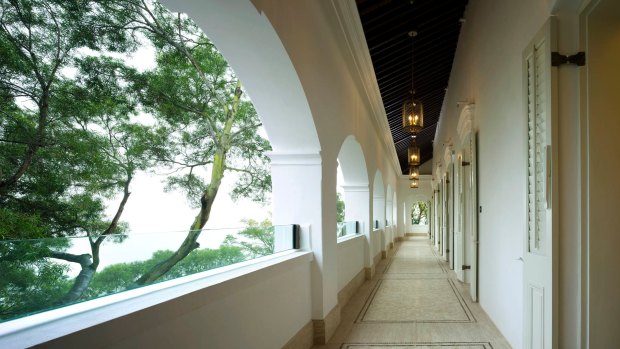
Colonnade at Tai O hotel.
The building served as a police station for a century before its closure and decline into a sorry state of disrepair. It's now listed in Hong Kong as a Grade II Historic Building and was one of six projects under a government restoration scheme of buildings of historical import. Following the station's restoration, the Tai O Heritage Hotel received a UNESCO Award of Merit in 2013, a year after its opening.
Aside from the odd shootout, one of the least savoury duties of the Marine Police in Hong Kong, according to A Stroll through Colonial Hong Kong was the retrieval of the bodies of victims of China's Cultural Revolution. Corpses, with their hands bound, would float down from the Pearl River in the People's Republic and into Hong Kong waters.
From the hotel it's an easy stroll into the charming fishing village, so ramshackle you feel like slapping a giant "fragile" sticker on it. On the way I pass humble homes whose frontages are filled with big plastic barrels containing squid paste, a commodity that is still produced here.
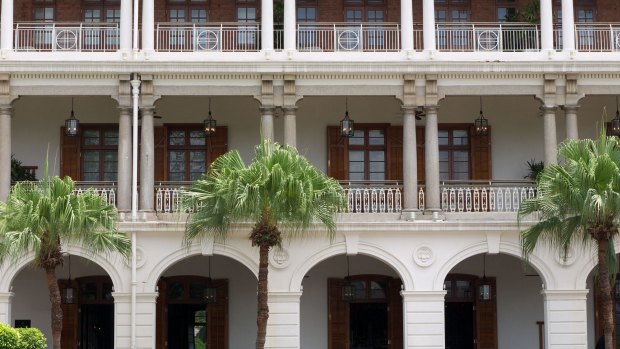
Hullett House - a hotel that's part of the 1881 heritage precinct.Credit: Alamy
Some of these houses, fashioned from scrap metal painted silver, are shaped to resemble the canopies of fishing boats with a lounge room, toilet and kitchen on the lower floor and bedrooms on the upper one, with taller Hong Kongers, let alone Westerners like me, having to stoop when inside. But the most distinctive features of Tai O are its stilt houses, some of which are a century old, built on fearfully spindly poles directly over a network of canals with the village inevitably being dubbed a Venice of the east.
The village's population is declining and it seems to be populated almost exclusively by elderly conical straw hat-wearing fisher folk, their skin deeply bronzed and weathered by their outdoors life. As I wander Tai O streets, I can sense that in its heyday, under the British, it would have been a challenging and rambunctious place for police to keep law and order.
My visit to Tai O is a brief one and, after an excellent lunch at a seafood restaurant, it's time to head into Hong Kong proper where, across the harbour at Kowloon, stands another handsome colonial-era police station. The Marine Police Headquarters at Tsim Sha Tsui is now an upmarket hotel. The original building was completed in 1884 but the rather ungainly faux-colonial retail and dining complex built below is called 1881 Heritage because its superstitious owner saw it as a more auspicious year.
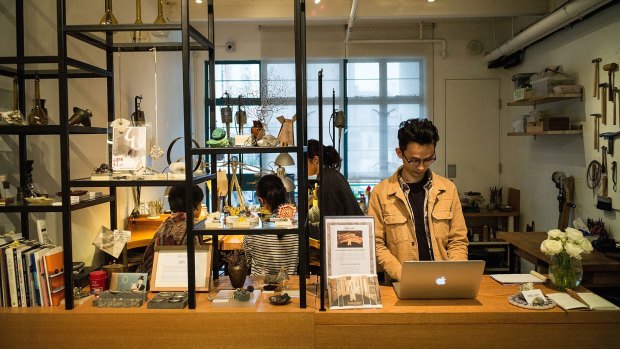
An accessory making workshop in PMQ.Credit: Getty Images
During World War Two, the Japanese Imperial Navy took over the building for its headquarters, with the nearby Peninsula, Hong Kong's signature colonial era hotel, in turn, seized by the Japanese Army for the duration of the World War Two occupation. But you must head back across, or under the harbour, to the island to experience one of Hong Kong's boldest police station conversions.
It's the former Police Married Quarters, or PMQ as it's now called, in Central. It's a much more recent construction than the stations at Tai O and Kowloon with PMQ dating to 1951. As its name suggests, the complex was built for married Chinese rank and file police offers and consisted of 140 single rooms and 28 double rooms. The population of post-war Hong Kong was rapidly increasing at that time with the British – with one eye on the necessity for law and order in its colony and the other on the newly communist China across the border – recognising the need for a larger police force.
After it, like the station at Tai O, outlived its usefulness, the Police Married Quarters, was converted into today's impressive hub for the design and creative industries and communities. Allthe complex's former residential units have been converted into 100 or so studio spaces or offices for "creative entrepreneurs". There is even accommodation for visiting designers and an inviting, casual rooftop restaurant.
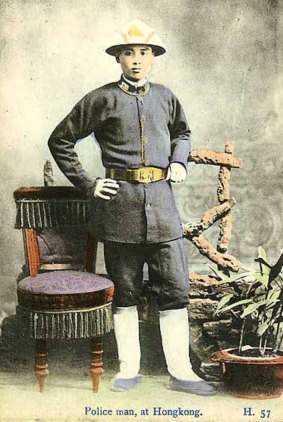
Studio portrait of a policeman in 19th century Hong Kong.Credit: Alamy
Most of the police officers living in PMQ would have worked in the nearby older, decommissioned Central Police Station on Hollywood Road which today is undergoing its own, protracted transformation. It's now the subject of a joint venture between the fantastically rich Hong Kong Jockey Club and the Hong Kong government.
In an ambitious project, more than a dozen eclectic heritage buildings of disparate design and building materials, are being transformed into a cultural and leisure precinct called Tai Kwun (meaning "big station" in Chinese). When finally completed, Tai Kwun will house modern art galleries and studios as well as restaurants and shops. The restoration of the complex, whose first structure opened in 1864, also includes the old Central Magistracy and the Victoria Prison. The project suffered a major setback last year when the facade of one of the buildings unexpectedly collapsed.
By the end of my sentence in Hong Kong I'm still left wondering what led the British to make quite such a heavy investment in Hong Kong cop shops. Wiltshire's book gives me a clue: "As Chinese law involved a gruesome list of tortures the more lenient [British-based] laws of Hong Kong made it doubly attractive to criminals."
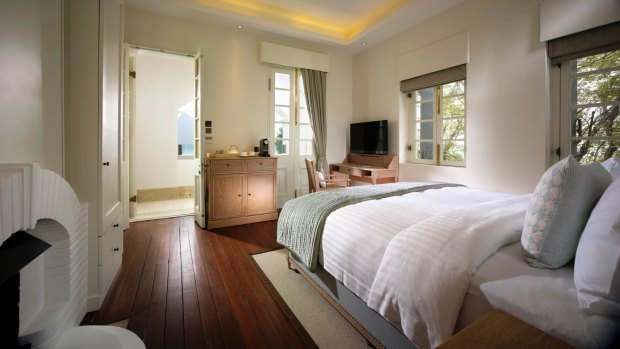
Tai O Heritage Hotel guest room.
The British have long gone from Hong Kong but its new rulers, with their belated preservation of Hong Kong's built heritage legacy, are certainly making the place a doubly attractive one for visitors like me.
FIVE MORE HONG KONG HERITAGE SITES TO SEE
FOREIGN CORRESPONDENTS' CLUB
Built in 1913, the brick and stucco, members-only FCC is in the Central district of Hong Kong Island. A former dairy farm depot, the FCC has occupied the building since 1982 and has commendably preserved the dark wood panelling interior with its famed long bar. See fcchk.org
DUDDELL STREET
At the end of this small street in Central is a set of attractive steps built in the second half of the 19th century. It's also the home of a quartet of gas lamps which the Hong Kong and China Gas Company maintains as objects of historical interest. Nearby is Duddells, a two Michelin star restaurant serving superb modern Chinese cuisine. duddells.co
STAR FERRY
Neither a building nor a site, the distinctive green and white Star Ferry boats remain as quintessentially Hong Kong as dim sum. Many Hong Kongers find the service, dating to 1880 too slow and crowded, preferring to take a taxi via the tunnels beneath Victoria Harbour. But there's no better way for a visitor to experience old and new Hong Kong. See starferry.com.hk
THE PENINSULA HONG KONG
Despite Hong Kong's rapid growth, the elegant Peninsula, or "The Pen" remains a dominant feature of Kowloon. Built in 1928, the Peninsula is to Hong Kong what the older Raffles is to Singapore. Both the surrender documents of first the British then the Japanese in World War Two were signed here. See peninsula.com
MOUNT DAVIS MILITARY SITE
One of Hong Kong's lesser known historical sites, not only does Mount Davis feature some fascinating ruins of its former World War Two British artillery depot, it also provides some magnificent harbour and city views. A tour operator, Eco Travel Limited, runs compelling four-hour guided tours of the site's network of eerily abandoned bunkers and gun emplacements. See hongkong.ecotravel.hk
TRIP NOTES
MORE
FLY
Cathay Pacific operates more than 70 flights a week to Hong Kong from six major Australian cities. There are four flights daily from Sydney and three daily from Melbourne. See cathaypacific.com/AU
STAY
Tai O Heritage Hotel, Shek Tsai Po St, Tai O. Doubles from $467. See taioheritagehotel.com; The Peninsula Hong Kong, Salisbury Road, Kowloon. Doubles from $829. See hongkong.peninsula.com; The Mandarin Oriental Hong Kong, 5 Connaught Road, Hong Kong. Doubles from $693. See mandarinoriental.com/hongkong; Landmark Oriental, 15 Queen's Road, Central, Hong Kong. Doubles from $708. See mandarinoriental.com/landmark
EXPLORE
The website of the Hong Kong Tourism Board includes several self-guided walking tours that encompass areas of heritage and architectural significance. A Stroll through Colonial Hong Kong by Trea Wiltshire is published by FormAsia. formasiabooks.com See PMQ, 35 Aberdeen Street, Central. See pmq.org.hk; Tai Kwun Centre for Heritage and Art, 10 Hollywood Road, Central. See taikwun.hk; 1881 Heritage, 2A Canton Rd, Tsim Sha Tsui. See 1818heritage.com
Anthony Dennis was a guest of the Hong Kong Tourism Board and Cathay Pacific
Sign up for the Traveller Deals newsletter
Get exclusive travel deals delivered straight to your inbox. Sign up now.